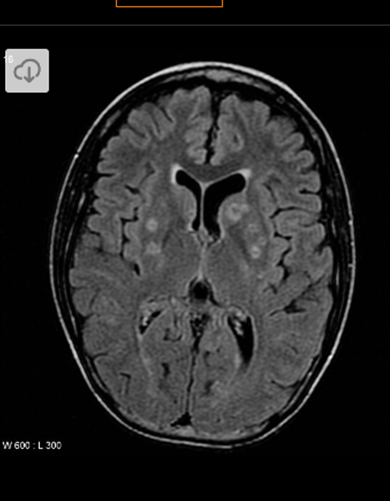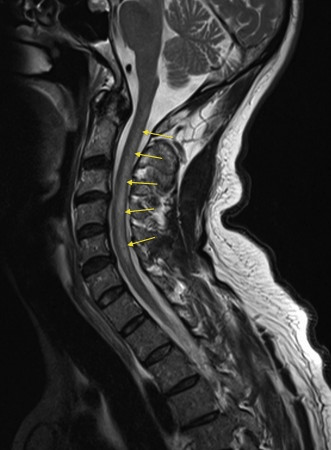Neurology
The hallmark tenet of a diagnosis of multiple sclerosis
What is dissemination in space and time?
The type of herpes virus causes the majority of herpes encephalitis in adults
What is HSV1
- 2/3rds of the cases are caused by reactivation from the central nervous system or by spready from another focus. 1/3rd of the cases are due to primary infection, either in the face—spready via the olfactory or trigeminal nerves or blood spread.
- HSV2 encephalitis is more commonly seen in neonates and immunocompromised individuals
The name of the robot at UH, that delivers medications
Who is Pill-Nelope
Name of the involuntary movement that may develop when taking Sinemet
What is a dyskinesia—can include tremors, head bobbing, fidgeting movements
The name of the ability to recognize an object by tactile sensation, with eyes closed, asking a patient to identify objects in their hand
What is stereognosis
The syndrome name for an acquired demyelinating neuropathy charachterized by opthalmoplegia, ataxia and areflexia?
What is Miller-Fisher Syndrome. Associated with ganglioside GQ1b antibody, present in 80% of those with this condition.
Bickerstaff brainstem encephalitis can overlap with some symptoms, also associated with GQ1b, includes altered conciousness, extensor plantar response and hyperreflexia due to CNS involvement.
What is the pro-inflammatory system involved in AchR positive myashtenia gravis?
What is the complement cascade?
AchR positive MG is IgG1 and IgG3 mediated disease, activated the complement cascade which is pro-inflammatory. The inflammation is part of the reason the NMJ gets destroyed. This is the reason why complement inhibitors such as Soliris, Ultomiris and Zilucoplan are able to be used in treatment of this type of MG.
The neurologist who coined a type of meningitis after his own last name with the following charachteristics: recurrent or chronic aspectic meningitis. Most common virus to do this is HSV, especially HSV 2.
Who is Pierre Mollaret. First described in 1944. The most common virus is HSV, but can be other viral causes as well including VZV. EBV, coxsackie, echovirus. Of note, PCR testing can be negative though the symptoms of meningitis are present and severe. Acyclovir is treatment of choice. Can resolve after 3 to 5 years, but some have a much longer disease course. Indomethacin 25 mg TID, can result in faster recovery.

A patient presents with altered mental status, fever, and change in speech. As part of work-up they are found to be leukopenic with WBC 2. You see several ring enhancing lesions above. Concern develops that patient has undiagnosed HIV and testing confirms this suspicion. What is the likely etiology of the ring-enhancing lesion above? It is not CNS lymphoma or cryptococcus.
What is Toxoplasmosis gondii? A intracellaluar protozoan parasite. Infection--ingest food or water contaminated by oocytes excreted by cats or improperly cooked eat. The tachyzoites multiple, invade cells and disseminate via blood and lymph system. If immunocompetent, can have a chronic, quiescent life-long infection without eradication.
In HIV, opportunistic infections occur when CD4 T-cell count is low.
It is estimated that 1/3rd of the global population has latent toxo.
In HIV patients--can present as encephalitis, chorioretinitis, pneumonitis, or disseminated diseaes. Predilection for the basal ganglia, frontal lobe, parietal lobe.
Symptoms can include fever, neuropsych symptoms, hallucinations, stroke-like symptoms.
Differential in an immunocompromised patient includes CNS lymphoma, PML, TB, focal cryptococcus, CMV, and bacterial brain abscess.
The lobe of the brain controls the following—the ability to identify an object in the hands with eyes closed
What is the parietal Lobe.
This lobe helps with processing somatosensory information—touch, pain, temperature, joint positio, integrating sensory information into a deeper meaning and helps with spatial orientaiton. Receive signals from the somatosensory cortex, thalamus, primary visual cortex of occipital lobe, primary auditory cortex of the temporal lobe
Integrates visual, acoustic and somatosensory information to understand and solve problems
When injured, individuals will experience:
- Hemineglect
- Cannot localize sensation
- Cannot recognize two point discrimination
- Cannot determine aspects of an object—its weight, texture and form
- May dress only half their body
- Anosognosia—indifference or lack of ability to recognize their condition
The percentage of patents with herpes simplex encephalitis who develop autoimmune encephalitis thereafter
What is 25%
- usually caused by NMDA receptor antibodies.
- Wide range of onset between 5 to 75 days post herpes encephalitis, though later onset and concurrent cases have been reported
The attending that was co-chief residents with your current attending?
Who is Dr. Guadalupe Fernandez Baca-Vaca
The name of the fluid-filled spaces that surround blood vessels in the brain. Origin is from German and French.
What is a Virchow-Robin spaces named after German pathologist Rudolf Virchow and French anatomist Charles Phillppe Robin
The essential vitamin that has a half-life of 18 days. Its deficiency is associated with beriberi.
What is thiamine? Needed for thiamine pyrophosphate, cofactor of citric acid cycle and needed for sugar breakdown. Citric acid cycle is necessary for carbohydrate, lipid, amino acid metabolism. Thus if thiamine deficient, one would inhibit many molecules including neurotransmitters glutamic acid and GABA. Thiamine is also involved in neuromodulation. Thiamine deficiency is thought to be major contributor to Wernickes in those with poor nutrition including ETOH abuse.
In contrast, the half-life of B12 is years (2-5 years in some studies). One area that B12 is stored is in the liver.
The inability to identify numbers or letters traced on the skin with a finger
What is Graphesthesia, which is a parietal lobe function
The brain region that if hurt can be involved in severe nausea, can be preferentially involved in NMO
What is the area postrema
What type of brain cell is the target of the condition that is most likely represented by the below images? 
What are astrocytes. Inflammation in NMO spectrum disorders primarily seem to target astrocytes. AQP4 is a water channel that is present in the foot processes of astrocytes. It is concentrated in the spinal cord gray mater, periaqueductal and periventrical areas.
The full name of the physician who described in 1817 patients with with: “Involuntary tremulous motion, with lessened muscular power, in parts not in action and even when supported; with a propensity to bend the trunk forward, and to pass from a walking to a running pace: the senses and intellects being uninjured.” He described 6 individuals, in a document titled “An essay on the Shaking Palsy”
Who is James Parkinson

The most common vitamin deficiency associated with the MRI Findings in this picture
What is B12 deficiency? Leading to subacute combined degeneration of the dorsal columns and lateral columns due to demyelination. Symptoms can include sensory deficits, paresthesias, weakness, ataxia, gait changes. Can lead to spasticity and plegia in severe cases.
We get cobalamin from meat, fish, dairy and eggs and fortified cereals. Richest sources are clams and animal liver. History taking should focus on diet, GI symptoms and history, autoimmune disease, and drug-induced causes including gastric acid suppressants, metformin, and nitrous oxide abuse. Lesser causes in the US are tapeworm infections and genetic causes.
A hypothesized reason why patients with nonfluent aphasia are able to sing when they are unable to speak fluently
What is an intact right hemisphere. The majority of people are left hemisphere language dominant. One theory is that the right hemisphere networks includes many areas that help with singing, however, this is just a theory and seems to be not fully proved yet. There is a form of therapy called Melodic Intonation Therapy (MIT). https://www.facebook.com/ossiamusicservices/videos/a-sample-of-melodic-intonation-therapy-for-brocas-aphasia/912171522562246/ ~ 1:30
The specific type of condition that can present with abdominal pain, confusion, psychiatric symptoms, autonomic instability, seizures, and a motor predominant neuropathy. The most likely of the possible subcategories.
What is Acute intermittent porphyria
severe porphyric neuropathy can occur in isolation without other preceding symptoms
peripheral neuropathy occurs in up to 40% of patients during an acute attack of porphyria
AIP is the form that is most commonly associated with neurological disease
The porphyrias are a group of metabolic disorders representing a diverse range of clinical symptoms according to the specific subtype and underlying enzymatic defect in the heme biosynthetic pathway caused by genetic mutations with a consequent overproduction of porphyrins, the essential intermediates of this pathway
The above is a pictorial of IgG. It is the only Ig that has the ability to exchange its arms as shown above. We talked about IgG. This question is
1.) What is the half-life of all IgG?
1.) Half life of IgG is 21 days. This is due to the FcRn system which essentially helps to recycle IgG. When IgG is bound to FcRn, it is protected from being degraded by lysosomes.
IgG4 -- Musk Myasthenia Gravis. This is important to know because an IgG4 mediated disease can be treated with medications such as Rituximab. Further, in AchR positive MG, the destruction is caused in part by activating the complement cascade. In MUSK MG, the destruction is not caused by the complement cascade. It is caused by blocking assembly of agrin-LRP4-Musk complex, results in slow dissembly of the AchR clusters--leads to less miniature endplate potential and EPP, leads to failed muslca action potential and weakness.
AchR MG is caused by IgG1 and IgG3.
2.) Half life of IgG is 21 days. This is due to the FcRn system which essentially helps to recycle IgG. When IgG is bound to FcRn, it is protected from being degraded by lysosomes.
For comparison, the half-life of
IgA and IgM- 4 to 6 days
IgE - 2 to 3 days (can be up to 9 to 12 weeks if bound to a particular receptor)
The neurologist who coined the term asterixis with colleague Raymond Adams in the 1940s.
Who is Joseph Foley. Dr. Foley is the father and founder of the neurological division at University Hospitals; under Dr. Foley he built a division of neurology within the Department of Medicine. Story goes that he consulted a Jesuit Scholar from Boston College. Dr. Foley and Father Cadigan drank metaxa (Greek spirit, a wine with botanicals) and came up with the term an (negative) - iso (equal), and sterixis (solidity of firmness). Anisoterixis was too many syllables, and thus shortened it to asterixis.
The reason why carbidopa is used in the commonly used Parkinson’s medication carbidopa-levodopa (Sinemet)
Carbidopa is an inhibitor of DDC and does not cross the blood-brain barrier, thus preferentially inhibiting the conversion of levodopa to dopamine outside of the brain.
Levodopa, the dopamine precursor, is converted into dopamine by L-dopa decarboxylase (DDC). This leads to increased production of dopamine. Therefore, levodopa is very effective in the management of Parkinson’s disease [3–6]. DDC is expressed by neurons in the central nervous system, liver, kidney, pancreas, and T lymphocytes [7–9]. Consumption of levodopa results in systemic production of dopamine, which limits production of dopamine in the central nervous system. In addition, activation of peripheral dopamine receptors results in nausea and vomiting. Carbidopa is an inhibitor of DDC and does not cross the blood-brain barrier, thus preferentially inhibiting the conversion of levodopa to dopamine outside of the brain.
What peripheral nerve sensory anatomy can be injured with EMG study showing normal sensory nerve conduction studies (normal amplitudes, velocities and latencies?
What is the sensory (or dorsal) root?